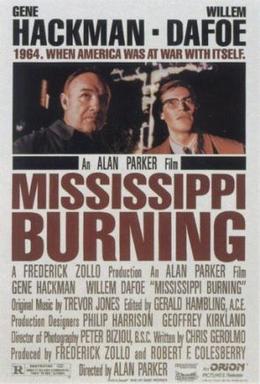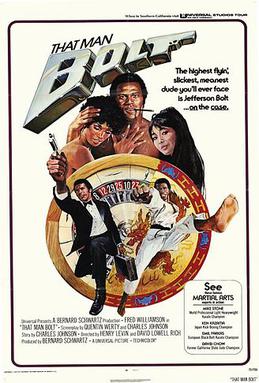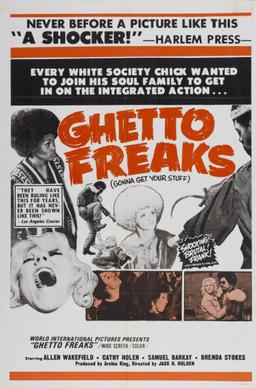
The Ku Klux Klan, commonly shortened to the KKK or the Klan, is the name of several historical and current American white supremacist, far-right terrorist organizations and hate groups. The Klan was "the first organized terror movement in American history." Their primary targets are African Americans, Hispanics, Jews, Latinos, Asian Americans, Native Americans, Italian Americans, Irish Americans, and Catholics, as well as immigrants, leftists, homosexuals, Muslims, atheists, and abortion providers.

Quentin Jerome Tarantino is an American film director, screenwriter, and actor. His films are characterized by stylized violence, extended dialogue including a pervasive use of profanity, and references to popular culture.

Mississippi Burning is a 1988 American crime thriller film directed by Alan Parker that is loosely based on the 1964 murder investigation of Chaney, Goodman, and Schwerner in Mississippi. It stars Gene Hackman and Willem Dafoe as two FBI agents investigating the disappearance of three civil rights workers in fictional Jessup County, Mississippi, who are met with hostility by the town's residents, local police, and the Ku Klux Klan.

Jackie Brown is a 1997 American crime film written for the screen and directed by Quentin Tarantino, based on the 1992 novel Rum Punch by Elmore Leonard. It stars Pam Grier as Jackie Brown, a flight attendant who smuggles money between the United States and Mexico. Samuel L. Jackson, Robert Forster, Bridget Fonda, Michael Keaton, and Robert De Niro appear in supporting roles.

Inglourious Basterds is a 2009 war film written and directed by Quentin Tarantino, starring Brad Pitt, Christoph Waltz, Michael Fassbender, Eli Roth, Diane Kruger, Daniel Brühl, Til Schweiger and Mélanie Laurent. The film tells an alternate history story of two plots to assassinate Nazi Germany's leadership—one planned by Shosanna Dreyfus, a young French Jewish cinema proprietor, and the other planned by the British but ultimately conducted solely by a team of Jewish American soldiers led by First Lieutenant Aldo Raine. Christoph Waltz co-stars as Hans Landa, an SS colonel in charge of tracking down Raine's group. The title was inspired by Italian director Enzo G. Castellari's 1978 Euro War film The Inglorious Bastards, though Tarantino's film is not a remake of it.

Frederick Robert Williamson, also known as "the Hammer", is an American actor and former professional football defensive back who played mainly in the American Football League (AFL) during the 1960s. Williamson has had a busy film career, starring as Tommy Gibbs in the 1973 crime drama film Black Caesar and its sequel Hell Up in Harlem. Williamson also had roles in other 1970s blaxploitation films such as Hammer (1972), That Man Bolt (1973) and Three the Hard Way (1974).

Pamela Suzette Grier is an American actress and singer. Described by Quentin Tarantino as cinema's first female action star, she achieved fame for her starring roles in a string of 1970s action, blaxploitation and women in prison films for American International Pictures and New World Pictures. Her accolades include nominations for an Emmy Award, a Golden Globe Award, a Screen Actors Guild Award, a Satellite Award and a Saturn Award.
Michael Thomas Bass is an American former professional football player who was a cornerback for the Washington Redskins of the National Football League (NFL) from 1969 through 1975. He appeared in 104 consecutive games for the Redskins, recorded 30 interceptions, and scored the Redskins' only touchdown in Super Bowl VII on a 49-yard fumble return. In 2002, Bass was selected as one of the 70 greatest Redskins players of all time.

Death Proof is a 2007 American slasher film written and directed by Quentin Tarantino. It stars Kurt Russell as a stuntman who murders young women with modified cars he purports to be "death-proof". Rosario Dawson, Vanessa Ferlito, Jordan Ladd, Rose McGowan, Sydney Tamiia Poitier, Tracie Thoms, Mary Elizabeth Winstead, and Zoë Bell co-star as the women he targets.

The Legend of Nigger Charley is a 1972 blaxploitation Western film directed by Martin Goldman and starring Fred Williamson in the title role. The story of a trio of escaped slaves, it was released during the heyday of blaxploitation. Shot in Charles City, Virginia, Eve's Ranch, Santa Fe, New Mexico, Jamaica, and Arizona, it received backlash for its controversial title.

Roy Lee Jefferson is an American former professional football player who was a wide receiver in the National Football League (NFL) for 12 seasons with the Pittsburgh Steelers, Baltimore Colts, and Washington Redskins. He played college football for the Utah Utes. During 162 regular season games in the NFL, he had 451 receptions for 7,539 yards and 52 touchdowns.

Blaxploitation is an ethnic subgenre of the exploitation film that emerged in the United States during the early 1970s. The term, a portmanteau of the words "black" and "exploitation", was coined in August 1972 by Junius Griffin, the president of the Beverly Hills–Hollywood NAACP branch. He claimed the genre was "proliferating offenses" to the black community in its perpetuation of stereotypes often involved in crime. The genre does rank among the first after the race films in the 1940s and 1960s in which black characters and communities are the protagonists and subjects of film and television, rather than sidekicks supportive characters, antagonists or victims of brutality. The genre's inception coincides with the rethinking of race relations in the 1970s.

Jasper, Texas is a 2003 American made-for-television drama film directed by Jeffrey W. Byrd. The teleplay by Jonathan Estrin is based on a true story and focuses on the aftermath of a crime in which three white men from the small town of Jasper, Texas, killed African American James Byrd Jr. by dragging him behind their pickup truck.
Le Tari was an American actor who appeared in movies and television.

That Man Bolt is a 1973 American action film directed by David Lowell Rich and Henry Levin. It stars Fred Williamson in the title role of a courier and Byron Webster. The film combined several genres: blaxploitation, the martial arts film, and James Bond superspy films. It was filmed in Hong Kong, Macau and the United States and featured several martial arts experts in action: Mike Stone, World Professional Light Heavyweight Karate Champion, Kenji Kazama Japan Kickboxing Champion, Emil Farkas, European Black Belt Karate Champion, and David Chow, Former California State Judo Champion. It was titled Operation Hong Kong outside the United States. Peter Crowcroft wrote the novelization of the screenplay.

Black Gunn is a 1972 American neo-noir crime thriller film, directed by Robert Hartford-Davis and starring Jim Brown, Martin Landau, Brenda Sykes, Herbert Jefferson Jr. and Luciana Paluzzi. Baseball pitcher Vida Blue appears in a supporting role, as does former football player-turned-actor Bernie Casey.

Django Unchained is a 2012 American revisionist Western film written and directed by Quentin Tarantino, starring Jamie Foxx, Christoph Waltz, Leonardo DiCaprio, Kerry Washington, and Samuel L. Jackson, with Walton Goggins, Dennis Christopher, James Remar, Michael Parks, and Don Johnson in supporting roles. Set in the Old West and Antebellum South, it is a highly stylized, heavily revisionist tribute to spaghetti Westerns, in particular the 1966 Italian film Django by Sergio Corbucci. The story follows a slave who trains under a German bounty hunter with the ultimate goal of reuniting with his wife.

Ghetto Freaks is a 1970 American independent hippie exploitation film directed by Robert J. Emery and written by John Pappas and Robert J. Emery. It was filmed entirely in Cleveland, Ohio, and originally opened in Cleveland under the title Sign of Aquarius, alternately titled Love Commune.

Once Upon a Time...in Hollywood is a 2019 comedy-drama film written and directed by Quentin Tarantino. Produced by Columbia Pictures, Bona Film Group, Heyday Films, and Visiona Romantica and distributed by Sony Pictures Releasing, it is a co-production between the United States, United Kingdom, and China. It features a large ensemble cast led by Leonardo DiCaprio, Brad Pitt, and Margot Robbie. Set in 1969 Los Angeles, the film follows a fading actor and his stunt double as they navigate the rapidly changing film industry, with the looming threat of the Tate murders hanging overhead. It features "multiple storylines in a modern fairy tale tribute to the final moments of Hollywood's golden age."
Ronald Kogod Goldman was an American film producer and tennis player.

















